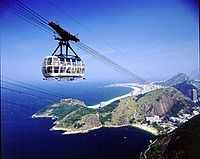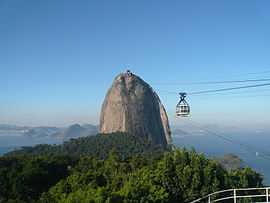Sugarloaf Cable Car
| Sugarloaf Cable Car Bondinho do Pão de Açúcar | |
|---|---|
|
Sugarloaf Cable Car | |
 | |
| Overview | |
| Location | Rio de Janeiro |
| Country | Brazil |
| Coordinates | 22°57′20″S 43°10′1″W / 22.95556°S 43.16694°W |
| Open | 27 October 1912 |
The Sugarloaf Cable Car; Portuguese: Bondinho do Pão de Açúcar) is a cableway in Rio de Janeiro, Brazil. Moving between Praia Vermelha and the Sugarloaf Mountain, it stops at Morro da Urca (at 722 feet (220 m)) on its way up and down, and reaches the summit of the 1,299-foot (396 m) mountain.
The cableway was envisioned by the engineer Augusto Ferreira Ramos in 1908 who sought support from well-known figures of Rio's high society to promote its construction. Opened in 1912,[1] it was only the third cableway to be built in the world. In 1972 the cars were updated, growing from a capacity of 22 to 75, and in 1979 it featured in an action scene for the James Bond film Moonraker. Today it is used by approximately 2,500 visitors every day. The cable cars run every 30 minutes, between 8 am and 10 pm.
History


The development of technical and engineering achievement of the National Exhibition in Commemoration of the First Centenary of the Opening of the Ports of Brazil to the International Trade in 1908 motivated engineer Augusto Ramos to imagine a cable car system in Rio de Janeiro. Ramos had to resort to well-known personages of Rio's high society. These included Eduardo Guinles and Raymundo Ottoni de Castro Maya, who were powerful figures with a range of developmental interests in the city,[2] to promote the idea of an electric cable system. When the cable car was built, there were only two others in the world: the chairlift at Monte Ulia, in Spain, with a length of 280 metres (920 ft), built in 1907,[3] and the lift at Wetterhorn, in Switzerland, with a length of 560 metres (1,840 ft), built in 1908.[4]
The Sugarloaf Cable Car was opened on 27 October 1912.[5][6] Its Portuguese-language name comes from the similarities between the cablecars, and the former trams in town. Envisioned by Augusto Ramos, it is managed by Companhia Caminho Aéreo Pão de Açúcar, a company created by Ramos.
The first cable cars were coated wood and were used for 60 years. Originally, the cable car stopped at Urca. In 1951, an accident occurred in which one of the two cables snapped, leaving 22 people dangling on one cable. One mechanic aboard, Augusto Goncales, climbed out and slithered down to Urca station and helped to build an emergency car to go back up and rescue the other passengers, 12 women and girls, 6 men and 3 children, in an event which took about 10 hours.[7] President Vargas praised Goncales as the "Hero of the Day".[7] In October 1972, a second cable was added, as well as new cabins, which expanded its capacity from 22 to 75;[8] eventually, it was reduced to 65 to increase comfort.[9] Prominent users of the service have included John Fitzgerald Kennedy, Lech Walesa, Gina Lollobrigida, Pope John Paul II, and Brooke Shields.
The cable car was the setting for the 1979 James Bond film Moonraker in which British secret agent James Bond (played by actor Roger Moore) battles with his nemesis Jaws (Richard Kiel) in the middle of the tramway, which eventually results in a tramcar with Jaws in it crashing into the ground station and smashing through the wall, although he miraculously survives. During the filming, the stuntman Richard Graydon slipped and narrowly avoided falling to his death. For the scene in which Jaws bites into the steel tramway cable with his teeth, the cable was actually made of liquorice, although Richard Kiel was still required to use his steel dentures.[10] Also in 1979, Las Vegas-based Steven McPeak walked the tightrope on the steel cable, the highest stretch of the cable car route, a feat which entered him into the Guinness Book of World Records.[11][12] On 18 January 1983, the route was expanded to Sugarloaf Mountain. In 2007, Falko Traber walked along the rope of the cable railway.[13] On the centenary of the cableway in 2012, Google honored it with a doodle, viewable in Brazil.[14][15]
Function

The cable cars run every 30 minutes, between 8 am and 10 pm.[16] They are glassed in for safety and have a capacity of about 65 people.[7][17]
The first part of the line, from the starting station to the stop off station at Morro da Urca, has a length of 600 metres (2,000 ft), with the maximum speed of 6 metres (20 ft) per second (21.6 kilometres per hour (13.4 mph)). Morro da Urca is situated at an altitude of 722 feet (220 m).[18] It contains a cafe, snack bar, restaurant, souvenir stands, and a children's play area.[16] The second part of the line, Morro da Urca to Sugarloaf, has a length of 850 metres (2,790 ft), with a maximum speed of 10 metres (33 ft) per second (36 kilometres per hour (22 mph)). The latter part of the trip up to 1,299 feet (396 m) on Sugarloaf, particularly towards the top, is very steep.[19]
References
- ↑ "History and Curious Facts". Sugarloaf Cable Car. Retrieved 19 November 2014.
- ↑ Bondinho do Pão de Açúcar: 95 anos da Companhia Caminho Aéreo Pão de Açúcar (in Portuguese). Andrea Jakobsson Estúdio. 2007. p. 44.
- ↑ Revista do Instituto Histórico e Geográfico Brasileiro (in Portuguese). 1988. p. 537.
- ↑ Engineering Abstracts from the Current Periodical Literature of Engineering and Applied Science, Published Outside the United Kingdom. Institution of Civil Engineers (Great Britain). 1928. p. 142.
- ↑ Bondinho do Pão de Açúcar: 95 anos da Companhia Caminho Aéreo Pão de Açúcar (in Portuguese). Andrea Jakobsson Estúdio. 2007. p. 47.
- ↑ Farias, Edson (1 January 2006). O desfile e a cidade: o carnaval-espetáculo carioca (in Portuguese). Editora E-papers. p. 210. ISBN 978-85-7650-057-5.
- ↑ 7.0 7.1 7.2 LIFE. Time Inc. 12 March 1951. p. 51. ISSN 0024-3019.
- ↑ Manchete (in Portuguese). Block Editores. 1997. p. 28.
- ↑ "Bondinho, 100" (in Portuguese). Folha.uol.com.br. Retrieved 15 August 2014.
- ↑ Moonraker Special Edition, Region 2 booklet. 2000.
- ↑ McWhirter, Norris (1 January 1985). Guinness Book of World Records 1985. Sterling Publishing Company, Incorporated. p. 326. ISBN 978-0-8069-0264-7.
- ↑ McFarlan, Donald; McWhirter, Norris (1988). Guinness book of world records. Bantam. p. 485. ISBN 978-0-553-27926-9.
- ↑ "Wire ropes and how they are used in modern technologies Wire, cable and wire-processing industries and the wire 2012 trade fair". http://www.tradefair.it/''. 2012. Retrieved 16 August 2014.
- ↑ "Sugarloaf Cable Car's 100th Anniversary". Google. 27 October 2012. Retrieved 16 August 2014.
- ↑ Scott, Damien (13 May 2013). "The 30 Best Google Doodles of All Time".
- ↑ 16.0 16.1 Blore, Shawn; Vries, Alexandra de (19 July 2006). Frommer's Portable Rio de Janeiro. John Wiley & Sons. p. 83. ISBN 978-0-470-04627-2.
- ↑ Rio de Janeiro. APA Publications Services. 2006. p. 143. ISBN 978-981-258-411-3.
- ↑ Vries, Alexandra de (13 January 2011). Frommer's Rio de Janeiro Day by Day. John Wiley & Sons. p. 17. ISBN 978-1-118-01950-4.
- ↑ Potter, Everett (1989). The Best of Brazil. Crown. p. 49. ISBN 978-0-517-57109-5.
External links
| Wikimedia Commons has media related to Bondinho. |
- Official website (Portuguese) (English) (Spanish)
| ||||||||||||||||||||||||||||||||||||||||||||||||||||||||||||||||||||||
